24 invasive plants to remove plus native alternatives to grow instead
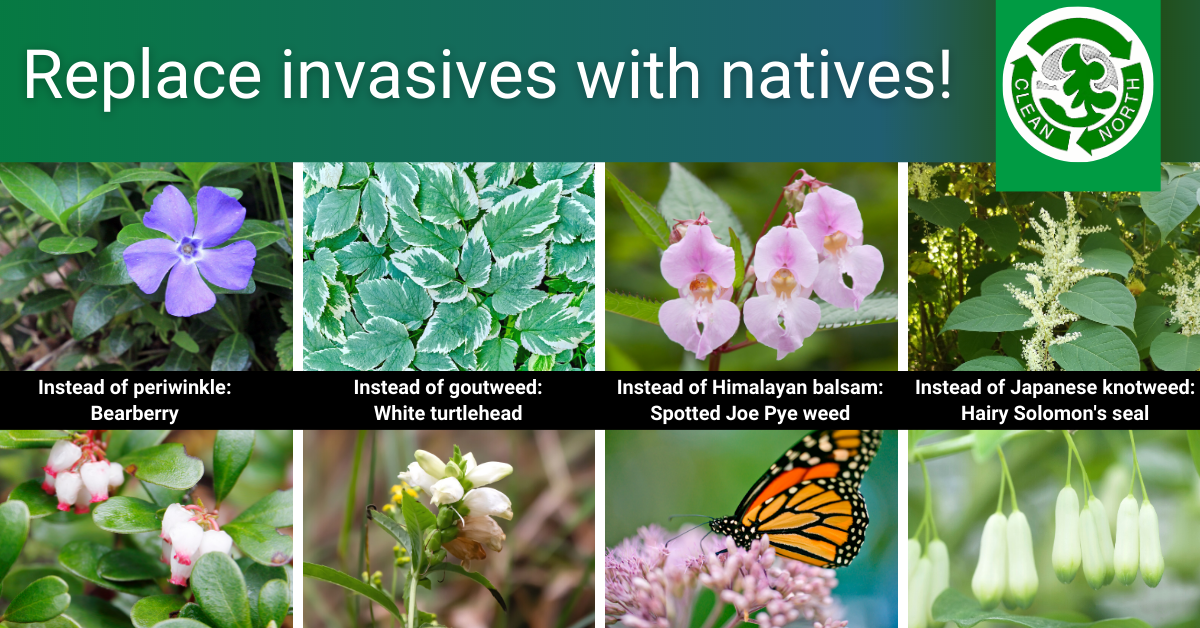
Which invasive plants are of greatest concern in Sault Ste. Marie and Algoma District, and what are some preferred native plants to grow instead? We set out to answer these questions with the help of a microgrant from the Invasive Species Centre and the support of many local partners (scroll to bottom for a list).
Note: This guide was created for Algoma District but it may be helpful to those living in other parts of the northern Great Lakes-St. Lawrence Forest region. Always confirm that a given species is truly native to your area or at least to Ontario. Also, you can access an abridged printable version of this guide here.
First, some definitions
- Native plant: One that grows naturally in our area without humans having introduced it.
- Non-native plant: One that was introduced to this area by humans. It’s not a natural part of our local ecosystems, and it may or may not be harmful.
- Invasive plant: A non-native plant that harms ecosystems, the economy, and/or society.
Why replace invasives?
Invasive plants can:
- Take over natural areas, crowding out native plants and reducing biodiversity
- Prevent the next generation of trees from sprouting and growing
- Reduce food and habitat for pollinators, birds, and other wildlife
- Harm people, for example, via caustic sap
- Affect recreation, for example, make shoreline areas difficult to get boats into
- Be very expensive to manage/remove
(Read article about Ontario auditor general report on invasive species.)
Not all non-native plants are bad. Hostas are not native to North America but you can grow them in your yard without worrying they will escape and cause problems in our natural areas.
Still, native plants have the eco-friendly edge as native pollinators, birds, and other wildlife evolved with and are adapted to them. While some non-native plants can provide habitat and food for native critters, the invasive ones come with baggage in the form of harm to ecosystems, people, or the economy.
And…you can have a spectacular, colourful garden with native plants. We’ve created an infographic showing 45 beautiful plants native to Algoma District. To see the entire graphic in a new window, click below.
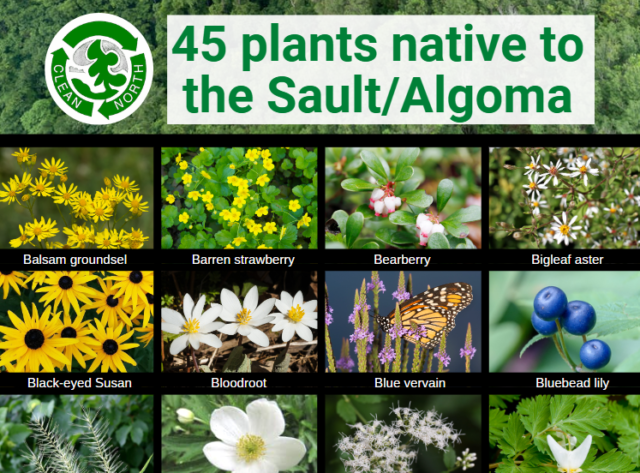
Where to start your invasive-to-native journey
Four phases:
- Inventory what’s growing in your yard
- Determine which are invasive
- Prioritize which invasives to remove first and get to work (more info; also see resources on Ontario Invasive Plant Council/OIPC site)
- Replace invasives with native plants or at least plants native to Ontario
Native to Algoma vs. native to Ontario
This guide has a unique feature: We list not one but two types of “grow me instead” alternatives to invasive plants:
- Native to Algoma
- Native to Ontario
We did this because it can be tough to source some species native to Algoma. Many of the plants we see in local nurseries that are labelled “native” are actually not native here. However, many of those native to other parts of Ontario benefit our pollinators, birds, and other wildlife. Anise hyssop, blazing star, and false sunflower are examples of species not native here but popular with pollinators and relatively easy to source.
When choosing which plants to grow instead of invasives, consider what your objectives are, what growing conditions each species needs (soil type, moisture needs, light needs), how tall and wide it grows—and whether you can source it. For example, some native plants tolerate occasional flooding or deep shade; others do not.
Two common native plant gardening objectives:
- “I want to mimic our local ecosystems as closely as possible.” Then you will want to plant as many Algoma natives as possible.
- “I want a beautiful garden with plants that support our pollinators/birds/other wildlife but am ok with plants native to other parts of Ontario.” That opens up your options.
Here’s a list of sellers of native plants in Ontario.
Also: You can buy or collect your own seed or (just do it responsibly) and grow native plants yourself (winter sowing is a cheap/easy method).
Check and double-check native status of species
Always double check to make sure a plant:
- Is the species you think it is. For example, wood lily (Lilium philadelphicum) is easily confused with non-native orange lilies.
- Is native to our area or at least to Ontario. The species distribution maps on iNaturalist are helpful for determining whether a species is native to Algoma or at least Ontario. But confirm via a second source as iNaturalist includes sightings of plants present here but native to elsewhere in Ontario as well as non-native/invasive plants that have taken hold in our natural areas.
- Is truly native and not a cultivar (variety bred by humans for desirable traits such as more petals). For example, native eastern red columbine is better for pollinators than are fancy ruffled columbine cultivars. Breeding varieties with more petals can lead to fewer pollen-producing stamens and even sterile plants that produce no pollen or seed. Less pollen/seed means less food for wild creatures.
Invasive spring bulbs/annuals plus alternatives
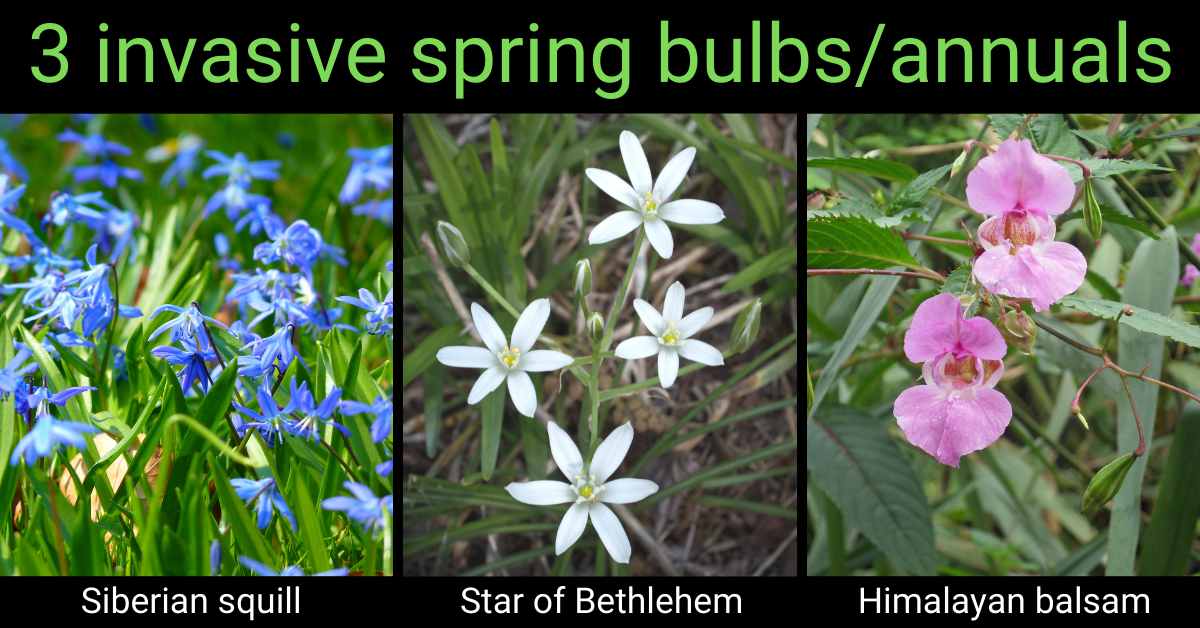
1. Siberian squill (Scilla siberica)
Grow instead:
- Native to Algoma: Bunchberry (Cornus canadensis), round-lobed hepatica (Anemone americana), yellow trout lily (Erythronium americanum)
2. Star of Bethlehem (Ornithogalum umbellatum)
Grow instead:
- Native to Algoma: Bloodroot (Sanguinaria canadensis), Canada anemone (Anemonastrum canadense), large white trillium (Trillium grandiflorum), wood anemone (Anemone quinquefolia)
3. Himalayan balsam (Impatiens glandulifera)
See technical bulletin on OIPC website
Grow instead:
- Native to Algoma: Annual—spotted jewelweed (Impatiens capensis); perennials—eastern red columbine (Aquilegia canadensis), spotted Joe-Pye weed (Eutrochium maculatum)
- Native to Ontario: Wild bergamot (Monarda fistulosa)
Invasive biennials/perennials plus alternatives
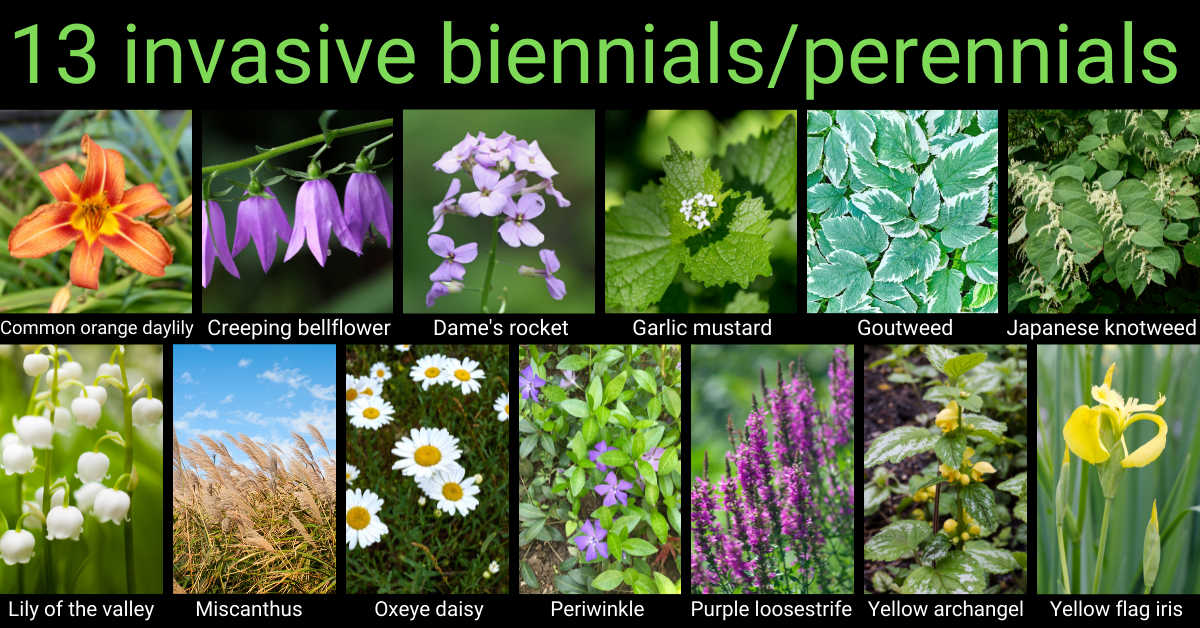
4. Common orange daylily (Hemerocallis fulva)
Grow instead:
- Native to Algoma: Wood lily (Lilium philadelphicum), lance-leaved coreopsis (Coreopsis lanceolata), swamp milkweed (Asclepias incarnata)
- Native to Ontario: Michigan lily Lilium michiganense), butterfly milkweed (Asclepias tuberosa)
5. Creeping purple bellflower (Campanula rapunculoides)
Grow instead:
- Native to Algoma: Bigleaf aster (Eurybia macrophylla), New England or smooth aster (Symphyotrichum novae-angliae/S. laeve), northern cranesbill (Geranium bicknellii)
- Native to Ontario: spotted geranium (Geranium maculatum)
6. Dame’s rocket (Hesperis matronalis)
Grow instead:
- Native to Algoma: Blue vervain (Verbena hastata), spreading dogbane (Apocynum androsaemifolium)
- Native to Ontario: Great blue lobelia (Lobelia siphilitica), showy tick-trefoil (Desmodium canadense)
7. Garlic mustard (Alliaria petiolata)
See best management practices guide on OIPC website
Grow instead:
- Native to Algoma: Balsam groundsel (Packera paupercula), long beech fern (Phegopteris connectilis), tall meadow-rue (Thalictrum pubescens)
- Native to Ontario: Wild ginger (Asarum canadense)
8. Goutweed (Aegopodium podagraria)
See best management practices guide on OIPC website
Grow instead:
- Native to Algoma: Canada anemone (Anemonastrum canadense), foamflower (Tiarella cordifolia), white turtlehead (Chelone glabra)
- Native to Ontario: Spotted beebalm (Monarda punctata)
9. Japanese knotweed (Reynoutria japonica)
See best management practices guide on OIPC website
Grow instead:
- Native to Algoma: Spotted Joe-Pye weed (Eutrochium maculatum), false Solomon’s seal (Maianthemum racemosum), hairy Solomon’s seal (Polygonatum pubescens)
- Native to Ontario: Black cohosh (Actaea racemosa), Culver’s root (Veronicastrum virginicum)
10. Lily of the valley (Convallaria majalis)
Grow instead:
- Native to Algoma: Bluebead lily (Clintonia borealis), Dutchman’s breeches (Dicentra cucullaria), northern starflower (Lysimachia borealis), small white leek (Allium tricoccum)
11. Miscanthus grasses (Miscanthus species)
Grow instead:
- Native to Algoma: Rattlesnake manna grass (Glyceria canadensis), bottlebrush grass (Elymus hystrix)
- Native to Ontario: Big bluestem grass (Andropogon gerardi), prairie dropseed (Sporobolus heterolepis)
12. Oxeye daisy (Leucanthemum vulgare)
Grow instead:
- Native to Algoma: Black-eyed Susan (Rudbeckia hirta), common boneset (Eupatorium perfoliatum), pearly everlasting (Anaphalis margaritacea), flat-topped white aster (Doellingeria umbellata),
- Native to Ontario: False sunflower (Heliopsis helianthoides)
13. Periwinkle (Vinca minor)
Grow instead:
- Native to Algoma: Bearberry (Arctostaphylos uva-ursi), wild or woodland strawberry (Fragaria virginiana/F. vesca), barren strawberry (Geum fragarioides), wintergreen (Gaultheria procumbens)
- Native to Ontario: Woodland phlox (Phlox divaricata)
14. Purple loosestrife (Lythrum salicaria)
Grow instead:
- Native to Algoma: Fireweed (Chamaenerion angustifolium), swamp aster (Symphyotrichum puniceum), swamp milkweed (Asclepias syriaca)
- Native to Ontario: Anise hyssop (Agastache foeniculum), blazing star (Liatris spicata)
15. Yellow archangel (Lamiastrum galeobdolon)
Grow instead:
- Native to Algoma: Foamflower (Tiarella cordifolia), northern evening primrose (Oenothera parviflora), two-leaved toothwort (Cardamine diphylla), wild sarsaparilla (Aralia nudicaulis)
- Native to Ontario: Wood-poppy (Stylophorum diphyllum)
16. Yellow flag iris (Iris pseudacorus)
Grow instead:
- Native to Algoma: Northern blue flag iris (Iris versicolor), Marsh marigold (Caltha palustris)
- Native to Ontario: Golden Alexander (Zizia aurea), grey-headed coneflower (Ratibida pinnata)
Invasive shrubs plus alternatives
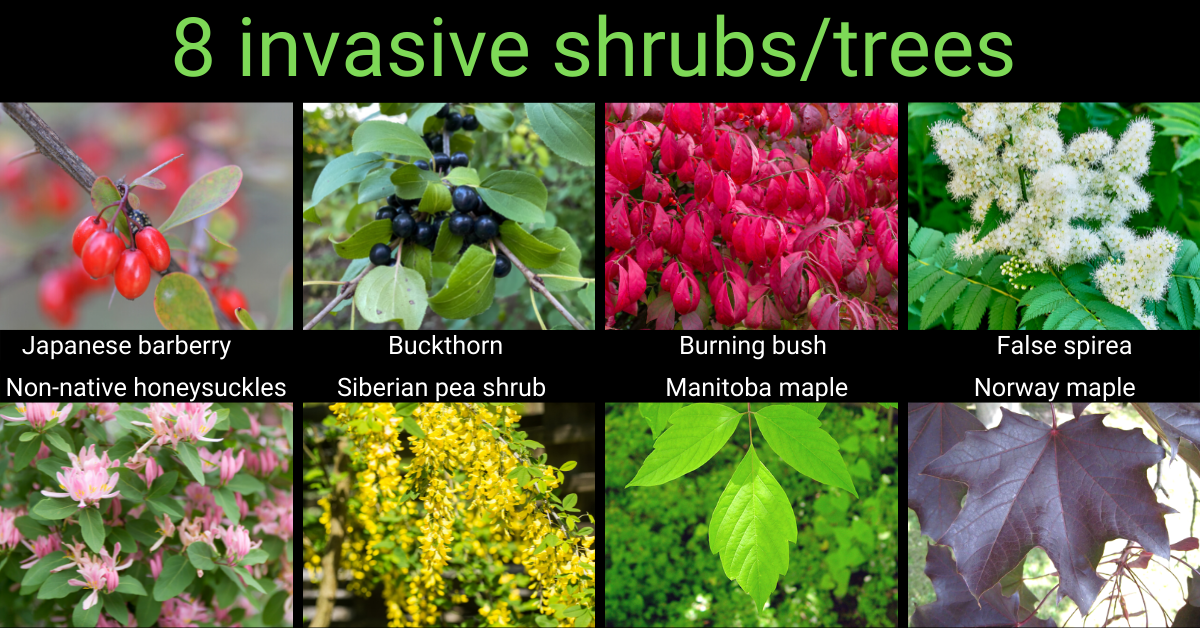
All “grow instead” shrubs listed below are native to Algoma. Other shrubs native to Ontario but not Algoma—for example, buttonbush (Cephalanthus occidentalis), New Jersey tea (Ceanothus americanus), and American witch-hazel (Hamamelis virginiana)—may do well here and offer benefits to pollinators, birds, and other wildlife.
17. Barberry, Japanese (Berberis thunbergii)
Grow instead:
- High bush cranberry (Viburnum opulus var. americanum)
- Red-osier or alternate-leaved dogwood (Cornus sericea/C. alternifolia)
18. Buckthorn, common/glossy (Rhamnus cathartica/Frangula alnus)
See best management practices guide on OIPC website
Grow instead:
- Canada elderberry or red-berried elder (Sambucus canadensis/S. racemosa), Saskatoon or smooth serviceberry (Amelanchier alnifolia/A. laevis)
19. Burning bush (Euonymus alatus)
Grow instead:
- Winterberry holly (Ilex verticillata)
- Northern wild raisin (Viburnum cassinoides)
- Sand cherry (Prunus pumila)
- Staghorn or smooth sumac (Rhus typhina/R. glabra)
20. False spirea (Sorbaria sorbifolia)
Grow instead:
- White meadowsweet (Spiraea alba)
- Steeplebush (Spiraea tomentosa)
21. Non-native bush honeysuckles (Lonicera tatarica, maackii, morrowii, ×bella)
Grow instead:
- Northern bush honeysuckle (Diervilla lonicera)
- American fly-honeysuckle (Lonicera canadensis)
- Smooth rose (Rosa blanda)
22. Siberian pea shrub (Caragana arborescens)
Grow instead:
- Beaked hazel (Corylus cornuta)
- Kalm’s St. John’s-wort (Hypericum kalmianum)
- Ninebark (Physocarpus opulifolius)
Invasive trees plus alternatives
All “grow instead” tree species listed below are native to Algoma. Other trees native to other areas of Ontario may do well here and offer benefits to pollinators, birds, and other wildlife.
23-24. Manitoba maple (Acer negundo) and Norway maple (A. platanoides)
See best management practices guide for Norway maple on OIPC website
Grow instead:
- Red maple (Acer rubrum)
- Mountain maple (Acer spicatum)
- Striped maple (Acer pensylvanicum)
- Sugar maple (Acer saccharum)
- White birch (Betula papyrifera)
- Yellow birch (Betula alleghaniensis)
- Red oak (Quercus rubra)
- Basswood (Tilia americana)
- Black cherry (Prunus serotina)
Bonus species! Scots pine (Pinus sylvestris)
See best management practices guide on OIPC website
Grow instead:
- Eastern white cedar (Thuja occidentalis)
- White pine (Pinus strobus)
- Red pine (Pinus resinosa)
- Tamarack (Larix laricina)
- White spruce (Picea glauca)
Sault/Algoma Grow Me Instead Guide—abridged printable colour brochure
Partners in/supporters of the Clean North Invasive Plant Species Education Project
- Sault Naturalists
- The Kensington Conservancy
- Sault College School of Natural Environment
- Sault Ste. Marie Region Conservation Authority
- City of Sault Ste. Marie
- Lake Superior Watershed Conservancy
- Bruce Station, St. Joseph Island, and Sault Ste. Marie horticultural societies
- Seedy Saturday Algoma
- Algoma Master Gardeners
- Johnson Farmers Market
We’d like to acknowledge Valerie Walker and Peter Burtch of the Sault Naturalists, Carter Dorscht of The Kensington Conservancy, botanical consultant Susan Meades, and Elisa Muto of Sault College for going above and beyond to provide input and support.
And finally, special thanks to the Invasive Species Centre and Bruce Station Horticultural Society for providing funding for our work.
Want to know more?
Visit our Gardening Info page for a longer list of invasive species, advice on how to grow native plants from seed through winter sowing, and much more. Other resources:
- Removing invasive plants can be challenging but is definitely doable
- Determining what’s a native plant can be tricky
- You can grow your own native plants through winter sowing (watch Kensington Conservancy/Clean North video on winter sowing)
- We’ve got tips on collecting your own native plant seed
Visit a municipal, university, or government library to access books like Forest Plants of Northeastern Ontario, The New Ontario Naturalized Garden, Ontario Wildflowers, and the ROM Field Guide to Wildflowers of Ontario. (When reading information on “wildflowers,” keep in mind that not all of them are native plants—more on that here.)
You can also:
- Email us at info@cleannorth.org
- Visit our Gardening Info page
- Follow us on social media at @cleannorthsault
